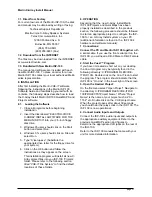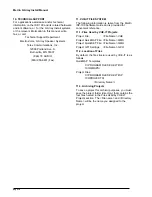
Merlin X-Array Install Manual
page 5
All the three-way systems have identical horizontal
coverage. In addition above 800 Hz, all the three-
way systems provide identical 60° (H) x 40° (V)
coverage. Below 800 Hz, the vertical coverage of
the three-way systems depends on the specific
system and the crossover used to drive it. The
Merlin ISP-100 provides processing that allows the
vertical coverage of the systems to be narrowed in
the upper bass and lower midrange (see the
following section on overlap versus non-overlap
configurations for details).
The three-way systems are described as follows:
2.2.1. XI-1153/64:
A 15-inch woofer three-way system with a 12-inch
horn-loaded midrange driver and 60° x 40° rotatable
constant-directivity HF horn.
Rated frequency response of 50 to 20,000 Hz.
Dimensions: 914 mm (36.00 in.) H, 586 mm (23.07
in.) W (front), 354 mm (13.93 in.) W (back), 759 mm
(29.88 in.) D.
Net weight 93.0 kg (205 lb).
2.2.2. Xi-1183/64:
An 18-inch woofer three-way system with a 12-inch
horn-loaded midrange driver and 60° x 40° rotatable
constant-directivity HF horn.
Rated frequency response of 40 to 20,000 Hz.
Dimensions: 914 mm (36.00 in.) H, 586 mm (23.07
in.) W (front), 354 mm (13.93 in.) W (back), 759 mm
(29.88 in.) D.
Net weight 93.0 kg (205 lb).
2.2.3. Xi-2153/64:
A dual 15-inch woofer three-way system with a 12-
inch horn-loaded midrange driver and 60° x 40°
rotatable constant-directivity HF horn.
Rated frequency response of 40 to 20,000 Hz.
Dimensions: 1233 mm (48.54 in.) H, 586 mm (23.07
in.) W (front), 354 mm (13.93 in.) W (back), 759 mm
(29.88 in.) D.
Net weight 113.4 kg (250 lb).
2.2.4. Xi-2183/64:
A dual 18-inch woofer three-way system with a 12-
inch horn-loaded midrange driver and 60° x 40°
rotatable constant-directivity HF horn.
Rated frequency response of 40 to 20,000 Hz.
Dimensions: 1233 mm (48.54 in.) H, 586 mm (23.07
in.) W (front), 354 mm (13.93 in.) W (back), 759 mm
(29.88 in.) D.
Net weight 113.4 kg (250 lb).
2.3.
X-Array Install Subwoofer
2.3.1.
Xi-1191:
A single 18-inch woofer vented-box subwoofer
system. Rated frequency response of 37 to 160 Hz
(normal mode) or 28 to 160 Hz (step-down mode).
Dimensions: 914 mm (36.00 in.) H, 586 mm (23.07
in.) W (front), 354 mm (13.93 in.) W (back), 759 mm
(29.88 in.) D.
Net weight 72.1 kg (159 lb).
3. OVERLAP VS. NON-OVERLAP
CONFIGURATIONS: A METHOD TO
INCREASE DIRECTIVITY
3.1.
Description
The three-way systems (Xi-1153/64, Xi-1183/64, Xi-
2153/64, and Xi-2183/64) can be operated in
standard three-way or overlap three-way
configurations. Overlapping increases the system’s
directivity and decreases the vertical beamwidth in
the important upper bass and lower midrange. It
does this by overlapping the operating ranges of the
woofer and midrange in the two-octave range
between 125 and 500 Hz. This directivity increase
much improves the lower-midrange punch of the
system in reverberant and semireverberant
environments.
Currently, the overlap configuration is offered only
for the 15-inch woofer three-way systems (Xi-1153/
64 and Xi-2153/64). A future release may include
support for the 18-inch woofer three-way systems
(Xi-1183/64 and Xi-2183/64).
As compared to the usual standard (non-overlap)
three-way configuration where the systems
woofer(s) is crossed over to the midrange at about
125 Hz, the overlap configuration lets the woofer(s)
operate two-octaves higher in frequency up to
about 500 Hz. This lets the woofer(s) and midrange
both operate in the 125 to 500 Hz range at the
same acoustical level and in phase with each other.
This significantly narrows the vertical coverage of
the system and increases the overall directivity
because the effective acoustic source size is larger.
The in-phase condition is very important because
this minimizes lobing error and keeps the directional
lobe faced straight ahead in the overlapped
frequency region. The Merlin ISP-100’s capability to
provide all-pass filters greatly contributed to
attaining this in-phase condition between the woofer
and midrange.
3.2.
Examples
The following graphs show the beamwidth versus
frequency and directivity versus frequency data for
the three-way systems operated in standard three-
way and overlap three-way modes. These
measurements were taken in EV’s large anechoic
chamber using an automated computer-operated
polar measurement setup.





































